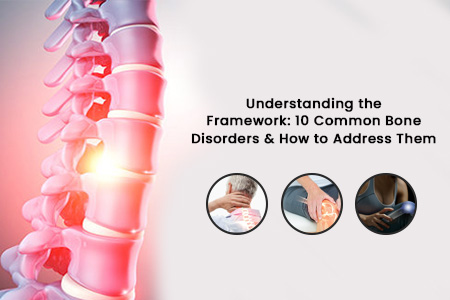2024-07-10
2024-04-12
2023-10-12
2023-09-13
2023-08-06
2023-08-04
2023-07-29
2023-07-05
2023-06-09
2023-02-03
2023-02-02
2023-01-06
2023-01-05
2023-01-04
2023-01-03
2023-01-02
2022-11-02
2022-07-30

Bones are the structural framework of our bodies, providing support, protection, and mobility. However, they are susceptible to various disorders that can compromise their function and integrity. In this article, we'll look into 10 common bone disorders, their causes, symptoms, and treatment options to help you better understand and address them.
1. Osteoporosis:
Osteoporosis is a condition characterized by weakened and porous bones, making them more prone to fractures. It often occurs due to aging, hormonal changes, or deficiencies in calcium and vitamin D. Symptoms may not manifest until a fracture occurs, highlighting the importance of preventive measures such as adequate nutrition, weight-bearing exercises, and medications to improve bone density.
2. Osteoarthritis:
Osteoarthritis is a degenerative joint disorder that commonly affects the knees, hips, and spine. It occurs when the protective cartilage between bones wears down over time, leading to pain, stiffness, and reduced range of motion. Management includes pain relief medications, physical therapy, and lifestyle modifications to alleviate symptoms and maintain joint function.
3. Rheumatoid Arthritis:
Unlike osteoarthritis, rheumatoid arthritis is an autoimmune disorder where the body's immune system attacks its own tissues, including the joints. This results in inflammation, pain, and eventual joint damage. Early diagnosis and aggressive treatment with disease-modifying antirheumatic drugs (DMARDs) are crucial in managing symptoms and preventing joint deformities.
4. Fractures:
Fractures, or broken bones, can occur due to trauma, repetitive stress, or weakened bones. They range from minor hairline fractures to severe breaks requiring surgical intervention. Treatment involves immobilization with casts or splints, followed by rehabilitation to restore function and strength to the affected area.
5. Scoliosis:
Scoliosis is a curvature of the spine, often diagnosed during adolescence, although it can develop at any age. While some cases are mild and require only monitoring, others may progress and cause pain, breathing difficulties, or deformity. Treatment options include bracing, physical therapy, or in severe cases, surgery to correct the curvature and stabilize the spine.
6. Osteomyelitis:
Osteomyelitis is a bacterial or fungal infection of the bone, usually resulting from an open wound or bloodstream infection spreading to the bone tissue. Symptoms include pain, swelling, and fever, and prompt treatment with antibiotics or surgical debridement is essential to prevent further complications such as bone necrosis or septicemia.
7. Paget's Disease:
Paget's disease is a chronic bone disorder characterized by excessive bone remodeling, leading to enlarged and weakened bones. While many individuals remain asymptomatic, others may experience bone pain, deformities, or fractures. Treatment aims to alleviate symptoms and prevent complications through medications to regulate bone turnover and manage pain.
8. Osteogenesis Imperfecta:
Osteogenesis imperfecta, or brittle bone disease, is a genetic disorder characterized by fragile bones that fracture easily, often with minimal trauma. It can range in severity from mild to life-threatening, and management focuses on preventing fractures, optimizing bone health, and addressing associated complications such as hearing loss or respiratory problems.
9. Fibrous Dysplasia:
Fibrous dysplasia is a rare bone disorder where normal bone is replaced with fibrous tissue, resulting in weakened and deformed bones. While some cases are asymptomatic and require no treatment, others may cause pain, fractures, or deformities requiring surgical intervention to stabilize the affected bones and improve function.
10. Bone Cancer:
Bone cancer can originate within the bone (primary) or spread from other sites (secondary or metastatic). Symptoms include bone pain, swelling, and pathological fractures, and diagnosis typically involves imaging studies and biopsy. Treatment may involve surgery, chemotherapy, radiation therapy, or a combination, depending on the type and stage of cancer.
Maintaining bone health is essential for overall well-being, and understanding common bone disorders can empower individuals to seek timely medical attention and appropriate management. Whether it's preventive measures, lifestyle modifications, or specialized treatment, addressing bone disorders requires comprehensive care. If you or a loved one are experiencing bone-related concerns, consider seeking assistance from reputable healthcare providers like Sree Manju Hospital, where skilled professionals can provide personalized care and support tailored to your needs. Remember, prioritizing bone health today can pave the way for a stronger and healthier tomorrow.